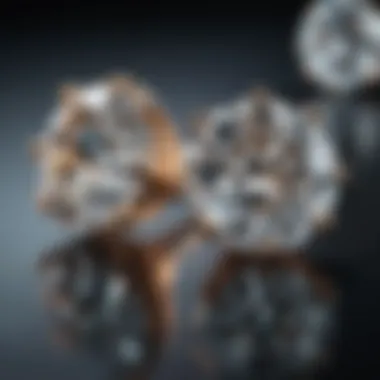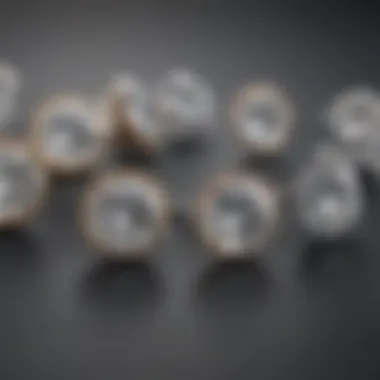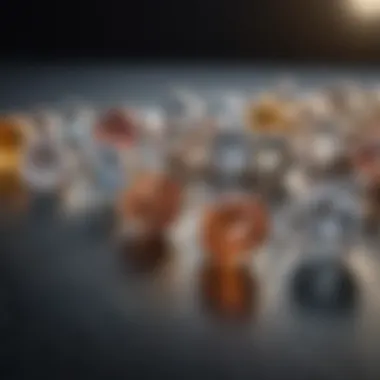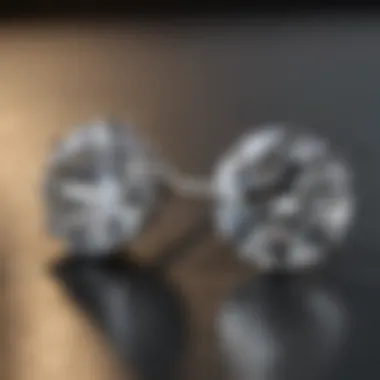Expert Tips for Selecting the Perfect Diamond Studs


Intro
Selecting the right diamond stud earrings can be a daunting task. With numerous factors to consider, it's essential to approach the process with knowledge and clarity. This guide aims to demystify the selection process, breaking it down into manageable sections. Understanding diamond quality, settings, personal style, and ethical considerations are all critical components in making an informed choice.
Diamonds are not only beautiful but represent significant investment. Therefore, it is crucial to understand their characteristics before purchasing. Both gemstone enthusiasts and newcomers will benefit from this comprehensive guide.
Gemstone Overview
Definition and characteristics
Diamonds are a form of carbon that has undergone extreme pressure and heat within the Earth's mantle. They are renowned for their brilliance and hardness, which make them ideal for jewelry. In terms of characteristics, diamonds are valued for their cut, color, clarity, and carat weight—commonly referred to as the Four Cs. These attributes significantly influence not only the aesthetic appeal but also the overall value of the gemstones.
Classification of gemstones
Diamonds fall into a unique category of gemstones known as precious stones. Unlike semi-precious stones, precious stones are rarer and generally considered more valuable. In the world of gemstone classification, diamonds stand out due to their hardness, scoring a 10 on the Mohs scale, which measures mineral hardness. This resilience is one of the reasons diamonds remain popular for engagement rings and other fine jewelry.
Properties of Gemstones
Physical properties
Diamonds exhibit several distinctive physical properties. Their refractive index is notably high, around 2.42, allowing them to reflect light in a way that enhances their sparkle. Additionally, they possess a specific gravity of about 3.5, which gives them weight without being overly cumbersome.
Chemical properties
From a chemical standpoint, diamonds are predominantly composed of carbon atoms. These atoms bond in a crystal lattice structure, resulting in their exceptional hardness and unique light performance. This purity also makes diamonds susceptible to chemical reactions under certain conditions, although they are generally resistant to most acids.
End
Choosing the right diamond studs involves understanding the broader context of gemstones. Awareness of both physical and chemical properties alongside gemstone classification will provide a strong foundation. This guide will continue to explore specific considerations, making the purchasing process clearer and more concise for the discerning buyer.
Understanding Diamond Quality
Understanding diamond quality is essential when choosing diamond studs. The quality of the diamond significantly influences its appearance, value, and overall desirability. By grasping the key elements of diamond quality, buyers can make informed decisions that align with their preferences and budget.
The Four Cs of Diamonds
The Four Cs serve as a universal language for assessing diamond quality. These four characteristics—Cut, Clarity, Color, and Carat Weight—are crucial in determining the beauty and worth of diamonds.
Cut
The cut of a diamond refers to how well it has been shaped and faceted. A well-cut diamond reflects light beautifully, showing off its distinctive sparkle. The key characteristic of cut is its ability to influence brilliance. A diamond cut too deep or too shallow will appear dull. Choosing a proper cut maximizes the diamond’s shimmer, making it a popular choice.
The unique feature of cut is that it affects the visual appeal, regardless of other qualities. However, a well-cut diamond may come at a higher price, which is a consideration for potential buyers.
Clarity
Clarity measures the presence of internal or external flaws in a diamond. Higher clarity means fewer blemishes, enhancing the diamond's brilliance. The key characteristic of clarity is transparency. A diamond with higher clarity can appear more vibrant. Many buyers prefer diamonds that are near flawless, making clarity a crucial characteristic.
However, diamonds with minor imperfections can often be more affordable. This opens options for those balancing quality and cost while still wanting a beautiful piece.
Color
Color in diamonds is graded based on the presence of color, with the clearest diamonds being colorless. The key characteristic is the absence of tint, which allows for maximum light reflection. Colorless diamonds are often seen as more valuable, making color a significant consideration during selection.
Nevertheless, diamonds with slight color can impart warmth, which some individuals may find desirable. The different tones may also make certain designs stand out.
Carat Weight
Carat weight is a measure of how much a diamond weighs. Typically, larger diamonds are more expensive. However, the key characteristic of carat weight does not independently define quality. A higher carat will not compensate for a poor cut or clarity.
The unique feature is its direct influence on value. But larger diamonds come with the responsibility of proper care and presentation, as they are more noticeable.


Importance of Certification
Certification authenticates the qualities of a diamond. It assures buyers of the diamond's attributes as represented by the seller. Understanding certification is important for informed purchases.
Recognized Certification Bodies
Recognized certification bodies, like the Gemological Institute of America (GIA) and the American Gem Society (AGS), evaluate and grade diamonds. The key characteristic of these bodies is trust. Their assessments lend credibility to a diamond's quality claims.
The unique feature here is the level of detail in their reports, which typically includes the Four Cs and more. Having a diamond certified by a reputable body often ensures the buyer’s confidence in their investment.
Reading a Diamond Certificate
Reading a diamond certificate equips buyers with knowledge about specific characteristics of their diamond. The key characteristic lies in understanding the distinctions between various ratings. Each grade illustrates the quality spanning across the Four Cs, giving the buyer a clearer picture.
This knowledge helps prevent misunderstandings with sellers and allows buyers to make educated decisions. Being able to read and interpret certification minimizes risks associated with purchasing.
Understanding diamond quality ensures that buyers know what they invest in. This knowledge leads to satisfaction in the long run.
Choosing the Right Setting
Choosing the right setting for diamond studs is a critical element in the overall presentation and wearability of the jewelry. The setting not only influences how the diamonds are displayed but also affects their protection and comfort while worn. A well-considered setting enhances the beauty of the diamond, showcasing its brilliance and fire through light interaction. Furthermore, it reflects personal style, as different settings can convey varied tastes and preferences. Understanding the various settings available is essential for making a well-informed decision.
Popular Setting Styles
Prong Setting
The prong setting is one of the most common and sought-after styles for diamond studs. In this design, a few metal prongs hold the diamond securely, creating a setting that captivates attention. The primary advantage of prong settings is their ability to allow maximum light to reach the diamond, enhancing its sparkle. This setting often carries a traditional elegance, making it a timeless choice for many buyers. However, it does have some disadvantages; the prongs can catch on clothing or hair, and they require regular maintenance to ensure they remain secure.
Bezel Setting
Bezel setting is another popular option for diamond studs. In this style, a metal rim surrounds the diamond, holding it securely in place. One key characteristic of bezel settings is their modern look, offering a sleek appearance. They provide excellent protection for the diamond, shielding it from potential damage. This makes bezel settings a practical choice, particularly for daily wear. However, the downside is that bezel settings may limit the amount of light that reaches the diamond, which can slightly reduce its overall brilliance.
Studs with Backs
Studs with backs incorporate a more integrated approach to design. In this method, the diamond is set into a specially designed backing, which can add an element of style and comfort. The unique feature of this setting is its secure feeling, as it typically prevents the diamonds from falling out. Many find this reassuring, especially for valuable pieces. However, not all designs allow for easy interchangeability of the stones, which may limit options for customization over time.
Material Considerations
When selecting the setting for diamond studs, the choice of material is equally significant. Each metal option contributes distinct characteristics, affecting durability, appearance, and price.
Gold
Gold remains a classic choice for diamond stud settings. It is available in various shades, including yellow, white, and rose gold. One primary characteristic of gold is its exceptional luster and warmth, which complements diamonds beautifully. Additionally, gold is durable, making it a suitable option for everyday wear. However, pure gold is soft, and may scratch easily, so understanding karat options is essential for balancing quality and durability.
Platinum
Platinum is recognized for its extraordinary strength and rarity. It is hypoallergenic, making it an excellent choice for those with sensitive skin. The key feature of platinum is its natural white sheen, which accentuates the beauty of diamonds. This choice is a beneficial one for its durability and ability to resist tarnishing. Nonetheless, it is generally more costlier than other metals, which should be a consideration for budgeting purposes.
Silver
Silver is another metal that can be used for diamond stud settings, offering a more affordable option. This material has a bright and versatile appearance, allowing diamonds to shine. However, it is softer compared to other metals and may tarnish over time. Regular polishing and proper care are necessary to maintain its luster. Silver settings can be appealing for those looking for stylish yet budget-friendly alternatives.
Choosing the right setting not only enhances the beauty of diamond studs but also reflects the buyer's personal style. The right combination of setting and material is essential for achieving both aesthetic appeal and practicality.
Assessing Personal Style and Use
Assessing personal style and use is a pivotal step in selecting diamond studs. It directs the choice based on how, when, and where the earrings will be worn. Understanding this aspect ensures the selected pieces resonate with the wearer’s lifestyle and preferences, making the purchase both meaningful and practical. Additionally, it helps avoid dissatisfaction down the line, which often stems from impulsive decisions.
Everyday Wear vs. Special Occasions
When contemplating diamond studs, one must evaluate whether they are intended for everyday wear or specific events. Everyday earrings should be versatile, comfortable, and less obtrusive. For example, smaller carat weights and simpler designs work well for daily use, providing a subtle elegance that enhances any outfit without overwhelming it.
On the contrary, diamond studs for special occasions can be more significant and extravagant. Higher carat weights and exquisite settings can be appropriate to create a statement or elevate evening wear. Recognizing the context in which the earrings will be worn allows for selections that are both functional and stylish.


Fashion vs. Timeless Designs
Then there is the differentiation between fashion and timeless designs. Fashion earrings change with trends and may challenge the notion of longevity in your collection. Trends can often be alluring but often do not hold up over time. Timeless designs, however, emphasize classic styling that transcends seasons and fads.
For individuals who value longevity and agelessness, it is wise to invest in diamond studs that feature minimalist settings and classic shapes. Round brilliant cuts remain universally appealing and adaptable across various styles. In contrast, opting for trendy designs may lead to quicker obsolescence, making it a less desirable investment.
Ultimately, assessing personal style and use provides clarity and direction in purchasing diamond studs. This approach makes it possible to choose pieces that align not only with current preferences but also offer lasting satisfaction and relevance.
Budget Considerations
Budget considerations play a pivotal role when choosing diamond stud earrings. Understanding your financial limits aids in narrowing down options while allowing clear focus on quality and style. A budget not only prevents overspending but makes it easier to select pieces that truly resonate with personal taste and values.
Setting a realistic budget before shopping can also guide discussions with jewelers, whether online or in physical stores. It encourages transparency and can lead to recommendations that align with your financial parameters. Furthermore, a thoughtfully established budget can enhance the shopping experience, mitigating stress associated with financial decisions.
Setting a Budget
Establishing a budget for diamond studs necessitates careful consideration of several factors. Begin by analyzing your financial situation and determining how much you are comfortable investing in jewelry. This decision can be impacted by various elements, including upcoming events or personal goals.
Here are some key actions to take when setting your budget:
- Evaluate financial priorities: Assess how buying these earrings fits into your larger financial picture.
- Research prices: Investigate similar jewelry pieces to get a sense of the market price.
- Consider future purchases: If you plan to buy more jewelry in the future, keep some financial flexibility.
Price Variations Based on Qualities
The price of diamond studs can vary widely based on several quality factors. While many focus on aesthetics, understanding how quality influences cost leads to more informed purchasing decisions.
The main aspects that cause price differences include:
- Carat weight: Larger diamonds have higher prices due to increased demand and scarcity.
- Cut quality: Higher cut grades are generally more expensive, as they dictate how well a diamond reflects light.
- Clarity grading: Diamonds with fewer inclusions or imperfections tend to command higher prices.
- Color quality: Nearly colorless diamonds often cost more than those with noticeable tint.
Diamond prices can fluctuate due to market trends, so taking time to understand these variations can significantly impact your purchasing experience.
A comprehensive approach to evaluating both budget and quality will ensure that you select diamond studs that meet your desires while being mindful of financial implications.
Ethical Sourcing and Sustainability
The significance of ethical sourcing and sustainability cannot be understated when selecting diamond studs. Consumers increasingly prioritize the values behind their purchases, particularly in terms of environmental impact and ethical considerations. This section delves into the responsibility of sourcing diamonds, highlighting the aspects of conflict-free practices and sustainable mining methods. These factors not only reflect one's personal values but also enhance the overall enjoyment and satisfaction from owning diamond jewelry.
Responsible Diamond Sourcing
Conflict-Free Diamonds
Conflict-free diamonds are stones that are sourced without funding violence or human rights violations. This fundamental aspect greatly contributes to the pursuit of ethical jewelry. Such diamonds showcase a key characteristic: traceability. This means that their origins can be verified, ensuring that every step from the mine to the market is devoid of unethical practices.
Many consumers opt for conflict-free diamonds due to their ethical implications. They represent a conscious choice to support a transparent supply chain. However, it is important to note that while most of these diamonds are marketed as conflict-free, skeptics argue about the efficiency of verification systems. Buyers should stay informed and specific about the certifications that guarantee these stones' ethical sourcing.
Benefits of choosing conflict-free diamonds include:
- Peace of mind: Knowing that the purchase does not contribute to conflict.
- Social responsibility: Supporting better mining practices helps communities thrive.
One disadvantage is the potential limitation of selection in some cases, as not all designs may offer conflict-free options. However, with advances in ethical sourcing, many jewelers strive to provide a wide range of choices.
Sustainable Mining Practices
Sustainable mining practices refer to operations that minimize environmental impact while maximizing community benefits. This aspect of diamond sourcing is critical in the context of ethical choices. Sustainable practices are increasingly favored because they not only address environmental concerns but also promote local economies.
Key characteristics of sustainable mining practices include:
- Environmental stewardship: Reducing pollution and habitat destruction.
- Community involvement: Ensuring local communities benefit from mining activities.
The importance of these practices lies in their long-term benefits. Adopting sustainable methods leads to rejuvenated ecosystems and improved quality of life for mining communities. However, challenges remain regarding the implementation of these practices universally.
While sustainable mining practices can raise costs and complicate logistics, long-term advantages often outweigh the initial downsides. Consumers can expect to find companies that are committed to responsibly sourced diamonds that adhere to these sustainable standards.


The Role of Certifications in Ethical Sourcing
Certifications play a crucial role in verifying the ethical sourcing of diamonds. Various organizations offer certification that guarantees a diamond's origins. Familiar certifications include the Kimberley Process Certification Scheme, which aims to prevent the trade in conflict diamonds. Certifying bodies provide a baseline of trust that can guide consumers in making informed decisions.
These certifications help retain consumer confidence and foster transparency throughout the diamond market.
Where to Purchase Diamond Studs
When considering the purchase of diamond studs, the retail option matters significantly. Where to purchase can influence not just the price but also the authenticity and quality of the diamonds. Understanding your options will help make a more informed decision, ultimately affecting satisfaction with the purchase.
Online Jewelers
Online jewelers have become a preferred choice for many when buying diamond studs. The convenience of shopping from home allows for broader comparison across brands, and many online retailers offer extensive selections that physical stores may lack.
Key benefits include:
- Competitive Pricing: Online prices often result from lower overhead costs. This generally means better deals without compromising quality.
- Detailed Information: Most websites provide comprehensive details about diamond quality, including cut, clarity, color, and carat weight. This data is essential when making a sound decision on your purchase.
- User Reviews: After purchase reviews from previous customers can provide insights into product quality and customer service, helping to guide prospective buyers.
- Return Policies: Many online jewelers offer generous return policies. This gives customers peace of mind, knowing they can return items if they do not meet expectations.
When opting for an online jeweler, it is crucial to choose recognized platforms and check for secure payment methods. Customization options are also a key consideration, as many online stores allow you to select specific attributes of your diamond studs, from size to setting.
Brick-and-Mortar Stores
On the other hand, brick-and-mortar stores provide a tactile shopping experience that online retailers cannot match. For diamond studs, seeing and touching the product could be imperative to ensure you are satisfied with its visual appeal.
Advantages include:
- In-Person Inspection: Customers can physically examine the diamonds under proper lighting. This often reveals aspects of quality that might not be visible in photographs on a website.
- Personal Service: Staff at these stores can provide tailored advice. They can guide you through the various options based on your preferences and budget.
- Immediate Possession: Unlike online purchases, where you must wait for shipping, buying in-store means you can take the earrings home immediately.
However, it is essential to check the reputation of brick-and-mortar stores. Look for reviews and ask about their return policy. The pricing might not always be as competitive as online options, so be prepared for potential higher costs, which can vary significantly among retail locations.
"Choosing where to buy your diamond studs can be as critical as selecting the diamonds themselves. Evaluate both online and in-person options to find what best suits your needs."
Caring for Your Diamond Studs
Caring for your diamond studs is essential to ensure their longevity and aesthetic brilliance. Many may assume that once they acquire these beautiful pieces, the journey ends. However, proper care significantly enhances the appearance and durability of diamond jewelry. Frequent wear or exposure to various elements can lead to tarnishing or dirt accumulation. Therefore, understanding how to clean, maintain, and store diamond studs properly can safeguard your investment and keep them sparkling for years to come.
Cleaning and Maintenance
Cleaning diamond studs is an important practice for anyone who wants to maintain their beauty. Over time, oils from skin, dust, or cosmetics can dull the diamonds' shine.
Regular cleaning can successfully remove build-up and keep your diamonds brilliant. Here are some recommendations for effective diamond stud maintenance:
- Soft Brush: Use a soft-bristled toothbrush to clean around the claws or settings gently. This will help remove trapped dirt without scratching.
- Soapy Water: A mixture of mild soap and warm water is often effective. Soak the earrings for 20-30 minutes, then use the soft brush to clean.
- Rinsing: Ensure you rinse them thoroughly in clean water to avoid soap residue.
- Drying: Use a lint-free cloth to dry your diamond studs carefully. This prevents scratches during the drying process.
Remember that ultrasonic cleaners can be useful but may not suit every type of jewelry. Always consult a jeweler about your specific diamond settings before use.
Storage Recommendations
Proper storage of your diamond studs protects them from scratches and damage when not in use. Simple storage practices can prolong their life and maintain their superb condition.
Here are some storage tips:
- Jewelry Box: Store diamond earrings in a designated jewelry box or a fabric-lined compartment to avoid scratching against other items.
- Individual Slots: If your box has multiple slots, place each diamond stud in its own compartment to prevent them from knocking against each other.
- Additional Protection: Consider wrapping each piece in a soft cloth if the jewelry box lacks adequate space.
- Controlled Environment: Avoid exposing stored jewelry to high humidity or extreme temperatures, as this may cause deterioration over time.
Tip: Regularly inspect your jewelry for any loose stones or damage, and address issues promptly to avoid further complications.
Final Thoughts
In the realm of jewelry, diamond stud earrings occupy a unique position. They are not just accessories; they serve as expressions of personality, style, and sentiment. When one approaches the task of choosing diamond studs, it becomes necessary to consider multiple factors extensively. This is more than simple aesthetics; it encompasses quality evaluation, setting choices, and ethical sourcing.
Every decision from quality assessment to personal preference can have implications. Understanding the nuances of diamond quality ensures that you are aware not only of what you are purchasing but also of the value it carries. Knowledge of the Four Cs—Cut, Clarity, Color, and Carat Weight—empowers the buyer, making them less susceptible to overspending on inferior options. Furthermore, navigating various settings and materials is crucial. The right setting can elevate even modestly priced studs, enhancing their visual appeal and durability.
Choosing based on personal style also plays a vital role. Different occasions demand different looks. Studs meant for everyday wear might differ significantly from those intended for special events. Therefore, understanding your wardrobe and lifestyle helps in making judicious selections. Moreover, as consumers become increasingly conscious of their choices, ethical sourcing cannot be overlooked. Selecting responsibly sourced diamonds reflects personal values and commitment to sustainability.
Ultimately, educated consumers are empowered consumers. Making informed decisions saves time, money, and ensures satisfaction. Given the significant financial commitment associated with diamond studs, every buyer should equip themselves with knowledge. A comprehensive understanding of these elements will not only streamline the purchasing process but also enhance the overall enjoyment of the jewelry.
"Knowledge equips you to navigate the complexities of your choices with confidence."
Every detail matters when investing in diamond studs. With careful consideration, one can find pieces that not only resonate with their style but also stand the test of time—both in design and value. Involving ethical considerations adds another layer of meaningfulness to the purchase. Thus, by weighing all these factors, anyone can confidently embark on their journey to select the perfect diamond studs.



